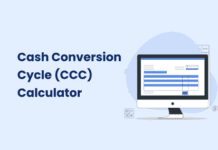In the fast-paced world of business, managing cash flow is a constant challenge that can make or break a company. One powerful metric to assess and enhance financial health is the Cash Conversion Cycle (CCC). By delving into its intricacies, businesses can unlock the secrets to operational efficiency, working capital optimization, and overall financial performance improvement.
In this blog, we aim to uncover the nitty-gritty of the cash conversion cycle, including its formula, calculation, and strategies to improve it.
Understanding the Cash Conversion Cycle (CCC)
The Cash Conversion Cycle (CCC) is a crucial indicator that measures the time it takes for a company to convert its investments in products and services into cash inflows. By focusing on this cycle, businesses can pinpoint areas for improvement in their operational processes, ultimately streamlining their financial operations.
In other words, CCC is a crucial financial metric, serving as a vital tool for businesses, regardless of their size. It effectively tracks the efficiency with which a company manages its inventory, collects payments from customers, and settles its payables with suppliers.
It is also important to note that the cash conversion cycle varies based on the nature of the business and industry. For example, sectors like fast-moving consumer goods (FMCG) and e-commerce often exhibit a rapid cash conversion cycle, indicating swift turnover. Whereas, industries such as heavy machinery manufacturing and construction typically encounter a more prolonged cycle.
Cash Conversion Cycle Calculation with Example
The cash conversion cycle is calculated by utilizing three working capital metrics:
Step 1: Calculating DSO
DSO is the measure of the average number of days it takes for a company to collect payment from its customer(s) after a sale is made.
| DSO = (Accounts Receivable / Net Credit Sale) X Number of Days |
Step 2: Calculating DPO
DPO is the measure of the average number of days a company takes to pay its suppliers/vendors after receiving the goods/services.
| DPO = (Accounts Payable / Cost of Goods Sold(COGS)) X Number of Days |
Step 3: Calculating DIO
DIO is the measure of the average number of days it takes for a company to sell its entire inventory.
| DIO = (Average Inventory / Cost of Goods Sold (COGS)) X Number of Days |
Step 4: Calculating CCC
The CCC is calculated using a straightforward formula:
| CCC = DIO + DSO – DPO |
Now, let’s take a look at an example to understand the calculation better:
Company XYZ Inc. has an average inventory of $50,000 and its Cost of Goods Sold (COGS) is $200,000 for the year 2022. Its receivables are $30,000, payables are $20,000, and net sales are $150,000.
So, DSO = ($30,000/$150,000)X365 = 73
DPO = ($20,000/$200,000)X365 = 36.5
DIO = ($50,000/$200,000)X365 = 91.25
Therefore, CCC= 91.25 + 73 – 36.5 = 127.75
It means company XYZ Inc. has a cash conversion cycle of 127.75 days.
What is a Good Cash Conversion Cycle?
When evaluating your cash conversion cycle, it’s crucial to recognize its industry and business-specific dependencies; there’s no universal benchmark. While a lower CCC is generally favored, the optimal target varies across industries. For instance, retailers typically exhibit a shorter CCC compared to manufacturers, thanks to their swifter inventory turnover.
In certain scenarios, even a negative CCC can be advantageous, indicating the ability to collect payments before meeting supplier obligations. Although unusual, this circumstance allows for positive cash flow without affecting the working capital.
A high CCC may signal difficulties in working capital management, potentially leading to short-term cash flow issues and liquidity concerns if unaddressed. It may also imply inefficiencies in inventory management, customer payment collection, or payable management.
Visualizing the cash conversion cycle’s trajectory, either in a declining or ascending trend, provides valuable insights. A decreasing trend signifies efficiency, while an upward movement suggests potential inefficiencies in business processes.
Why Tracking the Cash Conversion Cycle is Crucial?
Listed below are a few reasons that businesses of all sizes and industries should track the cash conversion cycle:
Working Capital Management
The CCC is a key indicator of how efficiently a company manages its working capital— the funds necessary for day-to-day operations. By optimizing the cash conversion cycle, a company may guarantee that it has enough working capital to pay operating expenditures and explore growth opportunities.
Operational Efficiency
The CCC offers insights into the efficiency of a company’s operational processes, including inventory management, sales, and payment cycles. Identifying and rectifying inefficiencies can lead to cost savings and improved overall performance.
Strategic Decision-Making
Businesses can use the CCC as a tool for strategic decision-making. For instance, a longer CCC may indicate a need to reassess inventory levels, renegotiate payment terms with suppliers, or implement changes in accounts receivable practices.
Investor and Vendor Confidence
An efficient cash conversion cycle indicates a well-maintained and agile business. This can enhance investor and vendor confidence, potentially leading to better credit terms, increased investment, and improved relationships with stakeholders.
Financial Health Monitoring
Regularly monitoring the cash conversion cycle provides a dynamic picture of a company’s financial health. Changes in the CCC can serve as early warning signs, indicating businesses to implement corrective actions and re-evaluate their strategies.
Strategies to Improve the Cash Conversion Cycle
Inventory Management: Streamlining inventory processes and adopting just-in-time practices can significantly reduce DIO, ensuring that capital is not tied up unnecessarily.
Accounts Receivable Optimization: Offering incentives for early payments, implementing efficient invoicing systems, and actively managing credit terms can accelerate cash inflows, minimizing DSO.
Supplier Negotiations and Payment Terms: Negotiating favorable payment terms with suppliers and strategically managing accounts payable can extend the DPO, providing more time to use available capital for other purposes.
Forecasting and Planning: Accurate forecasting of demand, sales, and cash flows enables proactive decision-making, preventing potential disruptions and optimizing the cash conversion cycle.
Technology Integration: Leveraging technology solutions such as automated accounts receivable, accounts payable, and inventory tracking tools can enhance efficiency in managing the CCC.
Peakflo’s Accounts Receivable and Accounts Payable solution streamlines financial processes, accelerating cash conversion cycles. By optimizing receivables management, the solution enables quicker collection, reducing DSO. Similarly, efficient payables automation optimizes DPO by enhancing invoice processing. This integrated approach significantly contributes to CCC optimization, ensuring a more agile and financially robust operation for businesses.
FAQ
What are the three components of the cash conversion cycle?
The cash conversion cycle comprises three elements: Days Inventory Outstanding (DIO), Day Sales Outstanding (DSO), and Days Payable Outstanding (DPO).
How is the cash conversion cycle measured?
The formula for calculating the cash conversion cycle is CCC = DIO + DSO – DPO, where DIO represents Days Inventory Outstanding, DSO represents Days Sales Outstanding, and DPO represents Days Payable Outstanding.
What does a high CCC and a low CCC mean?
A high CCC indicates that it takes a longer time to generate cash, which can be challenging, especially for small companies. In contrast, a low CCC suggests that the company is in good financial health, as it can quickly convert its goods or services into cash, which can then be reinvested or used to settle debts.
Can the CCC be negative?
Yes, a negative cash conversion cycle is possible. This occurs when a company sells goods or services before paying its suppliers, resulting in a negative CCC.









![Why AI Sales Calls Are Making Good Sales Reps Even Better [2025 Guide] ai sales calls](https://cdn-kmjmp.nitrocdn.com/YvtqmrsiHUxqerlSiZgbfzqqTARWTElr/assets/images/optimized/rev-834053b/blog.peakflo.co/wp-content/uploads/2025/09/65168cf6-3001-4733-8cbc-12d5684cf449-218x150.webp)

































